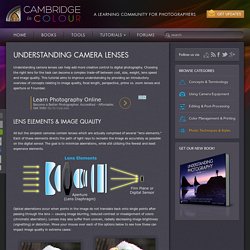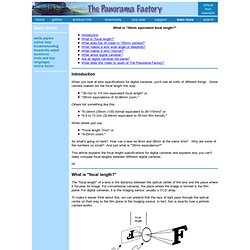

Zoom vs Prime. Understanding camera lenses can help add more creative control to digital photography.

Choosing the right lens for the task can become a complex trade-off between cost, size, weight, lens speed and image quality. This tutorial aims to improve understanding by providing an introductory overview of concepts relating to image quality, focal length, perspective, prime vs. zoom lenses and aperture or f-number. All but the simplest cameras contain lenses which are actually comprised of several "lens elements. " Each of these elements directs the path of light rays to recreate the image as accurately as possible on the digital sensor. The goal is to minimize aberrations, while still utilizing the fewest and least expensive elements. Optical aberrations occur when points in the image do not translate back onto single points after passing through the lens — causing image blurring, reduced contrast or misalignment of colors (chromatic aberration).
Original Image ZOOM LENSES vs. What is "35mm equivalent focal length?" Introduction When you look at lens specifications for digital cameras, you'll see all sorts of different things.

Some camera makers list the focal length this way: "38 mm to 115 mm equivalent focal length" or "35mm equivalence of 32-96mm zoom. " Others list something like this: "8–24mm [35mm (135) format equivalent to 38-115mm]" or "6.5 to 13 mm (32-64mm equivalent to 35-mm film format). " While others just say: "Focal length 7mm" or "9-20mm zoom. " So what's going on here? This article explains the focal length specifications for digital cameras and explains why you can't really compare focal lengths between different digital cameras. top What is "focal length? " Photography Novice: Focal Length and Aperture. Focal Length The focal length of a lens determines its angle of view, and also how much the subject will be magnified for a given photographic position.

Focal length also determines the perspective of an image. Longer focal lengths require shorter exposure times to minimize burring caused by the shake of hands. The Focal Length means how much can your camera see. Aperture The aperture range of a lens refers to the amount of light that the diaphragm can let inside the camera to reach the sensor. Apertures are listed in terms of f-numbers (expresses the diameter of the entrance pupil in terms of the effective focal length of the lens; It is the quantitative measure of lens speed), which are marked on the lens. Lenses with larger apertures are faster because, for a given ISO speed, the shutter speed can be made faster for the same exposure. Minimum apertures for lenses are almost as important as maximum apertures. To get the ebook, click here!